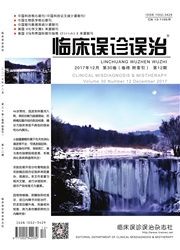

 中文摘要:
中文摘要:
目的总结需进行主动脉弓上动脉重建、累及主动脉弓的StanfordB型主动脉夹层(以下简称B型夹层)的腔内隔绝治疗经验。方法2001年10月-2009年3月我科对22例累及主动脉弓的B型夹层行腔内隔绝治疗,病变均累及距左锁骨下动脉开口15mm内。根据夹层形态选择应用移植物开槽、移植物开窗、“烟囱”式分支支架置入和弓上杂交技术等治疗方式。出院后6~12个月进行第1次主动脉CT血管造影(CTA)随访,后每年进行CTA随访1次,研究终点为疾病进展、出现严重并发症或死亡。结果本组出现手术相关并发症2例。术后随访7.5~51.3个月,平均27.1个月。1例因左锁骨下动脉覆盖造成术后脑梗死,术后6h行左颈外动脉-左椎动脉旁路手术,术后12d死亡。1例2期手术后出现心肌梗死,于术后7d死亡。应用移植物开槽技术的患者中,1例术后6个月出现左锁骨下动脉闭塞,但患者无相关缺血症状。在获得中、长期随访的20例中,所有旁路血管通畅、良好,无近端内漏或移植物移位,夹层假腔均出现血栓化,其中18例假腔直径缩小,平均缩小14.0mm,另2例假腔直径无变化。结论对累及主动脉弓的B型夹层,腔内隔绝手术是行之有效的。
 英文摘要:
英文摘要:
Objective To summarize experience of endovascular stent graft repair in descending aorta dissections which require supraaortic branch vessel revascularisation. Methods 22 patients with Stanford type B aortic dissection admitted during October 2001 and March 2009 underwent endovascular stent graft repair. Inclusion requirement was aortic landing zone proximal to the left subclavian artery within 15 ram. Treatment of hybrid, scalloped or fenestrated endovascular stent grafts was selected based on dissection characteristics. The first follow-up was made 6 - 12 months after discharge with CTA. Annual follow-up visits included computed tomography angiography. Destination included progressive pathology, complications and survival rates. Results 2 pa- tients had operative complication. The postoperative patients were followed up for 7.5 -51.3 months (average 27.1 months). Two patients died after surgery. One patient suffered form cerebral infarction in covered left subclavian artery, and a by-pass operation was performed 6 hours after operation hut died 12 days after operation. One patient suffered form myocardial infarction after two- stage operation and died 7 days after operation. One patient had left subclavian arterial occlusion 6 months after operation by apply- ing transplants gaining technical operation, but no postoperative complications occurred in the other patients. 20 patients were fol- lowed up for middle - long terms; blood flow remained in the false lumen distal to the exclusion area and was not covered by stent without proximate internal fistula or transplants malposition. Thrombosis formed in the aortic false lumen of the graft exclusion segment in all the patients. The maximum diameter of this segment in 18 patients had diminution, and the average diminution was 14. 0 ram. The maximum diameter of this segment had no change in other two patients. Conclusion Endovascular stent graft methods show a promise in endovascular stent graft repair in treatment of proximal descending aortic dissections invol
 同期刊论文项目
同期刊论文项目
 同项目期刊论文
同项目期刊论文
 Layer- and Direction-Specific Material Properties, Extreme Extensibility and Ultimate Material Stren
Layer- and Direction-Specific Material Properties, Extreme Extensibility and Ultimate Material Stren Open surgery (OS) versus endovascular aneurysm repair (EVAR) for hemodynamically stable and unstable
Open surgery (OS) versus endovascular aneurysm repair (EVAR) for hemodynamically stable and unstable The influence of constitutive law choice used to characterise atherosclerotic tissue material proper
The influence of constitutive law choice used to characterise atherosclerotic tissue material proper Management of complicated aortic aneurysms using multiple overlapping uncovered stents: mid-term out
Management of complicated aortic aneurysms using multiple overlapping uncovered stents: mid-term out Material properties of components in human carotid atherosclerotic plaques: A uniaxial extension stu
Material properties of components in human carotid atherosclerotic plaques: A uniaxial extension stu 期刊信息
期刊信息
